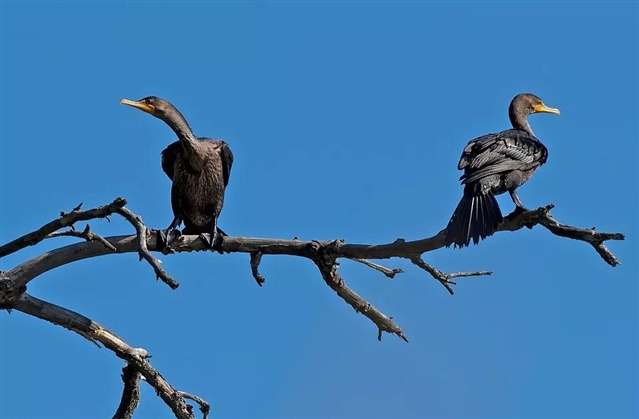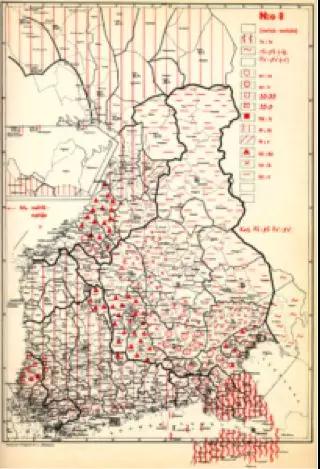|
|
|
|
|
环境与文化的相互作用,使我们“各说各的” | BMC Evolutionary Biology |
|
|
论文标题:Evolution within a language: environmental differences contribute to divergence of dialect groups
期刊:BMC Evolutionary Biology
作者:Terhi Honkola, Kalle Ruokolainen, Kaj J. J. Syrjänen, Unni-Päivä Leino, Ilpo Tammi, Niklas Wahlberg and Outi Vesakoski
发表时间:2018/09/03
数字识别码:10.1186/s12862-018-1238-6
原文链接:https://bmcevolbiol.biomedcentral.com/articles/10.1186/s12862-018-1238-6?utm_source=other&utm_medium=other&utm_content=null&utm_campaign=BSCN_2_DD_BMCEvoBio_Art_Scinet
微信链接:https://mp.weixin.qq.com/s/2EItGb7CZk860oYX1yVVLg
几个世纪以来,不同现代语言之间的分化一直是学术界很感兴趣的主题。有人提出,部分语言之间的分化来自于人群中的方言。也就是说,随着人群的相互隔离,方言慢慢演变成了不同的语言。
在接下来的文章中,Terhi Honkola介绍了她和同事们在BMC Evolutionary Biology上发表的研究,该研究主要探索了具有语言能力的人群的相互隔离以及当地环境条件是否与语言多样性有关。

乍一看,语言和演化之间的共同点似乎少得可怜。然而,仔细观察就会发现,进化最核心的三个部分——变异、遗传和促变因素(例如“选择”)也存在于语言中。
达尔文已经注意到了语言和生物演化之间的相似性,自那之后也有许多学者对此进行了详细阐述,因此使用现代演化生物学的方法来分析语言数据是具有合理性的。
这类研究中的大多数侧重于构建印欧语系、南岛语系和乌拉尔语语系的系统发生树。反过来,这些系统发生树也能用于研究这些群体的分类学以及他们逐步分散隔离的历史。
在这些研究中,语言与物种是同一水平的。由于这两者都具有等级性质,因此也可以认为其子结构——方言和种群,是同一水平的,因此种群遗传方法可以用于方言数据分析。我们研究组的前期工作也已经证实了这一点。
在我们此次的研究中,我们将生物学和语言学进一步结合起来。除了采用种群遗传学方法之外,我们还使用了生物微演化框架的某些要素。
我们的研究目的是推动对语言分化的认识。语言分化对于现有7000多种语言的出现具有重要意义。
在生物学中,我们可以在分化过程的早期阶段研究物种分化,这主要涉及物种内的种群分离。此次,我们的研究主要关注也是“种群分离”的早期阶段,也就是语言中方言分离的初始阶段。
我们的假设是基于生物学和语言学文献作出的。首先,我们研究了地理距离的作用,因为它有助于推动人群和方言的分化。一般来说,群体彼此之间的地理距离越远,其分散平衡性就越差,群体之间的差异性也就越大。
其次,基于环境隔离这一生物学假设,我们研究了仅靠环境条件的差异是否能隔离开具有语言能力的群体,以及环境隔离在方言分化中是否发挥作用。
最后,我们研究了文化差异是否能够解释语言差异。文化,特别是其累积效应,是人类区别于其他动物的重要特征。
百年间芬兰语的变化
我们研究了芬兰语中的方言的分化情况。此次研究中,我们使用的数据库描述了大约一百年前芬兰语中的方言情况(图1)。由于芬兰的城市化进程相对较晚,因此这些数据产生时方言之间的差异仍然很明显。

《芬兰语方言地图集》(Dialect Atlas of Finnish)的示例页面 来源:Kettunen, 1940
为了了解不同方言群体之间的差异,我们使用了种群遗传聚类方法对这些群体进行推断。为此,我们用类似于遗传数据的方式对语言数据进行了整理。
在生物学中,研究的单位是个体。那么在个体的体内,我们通常需要研究某些基因座上的等位基因。在方言数据中,我们想了解对地方行政单位(即市政单位)内某些语言特征的局部变体。因此我们做了一下类比,个体与市政单位为同一水平,基因座与语言特征为同一水平,等位基因与语言特征变异统一水平。
我们还找到了有关芬兰各种文化和环境特征空间分布的历史记录。芬兰是一个环境和文化相对同质的国家,这使得我们能够研究环境和文化条件的微小差异是否与语言分化存在某种联系。
出乎意料的是,我们发现地理距离对于方言群体之间的语言差异的作用微乎其微。换句话说,在地理位置邻近的土地上讲的方言完全可能在语言学上完全不同。
虽然文化差异已经能够解释大部分语言差异,但环境差异应该不仅仅影响地理距离,它也与语言差异有关。环境和文化的相对作用大小是本研究的一个重要发现,我们发现文化适应可能影响芬兰方言的分化。
根据我们的研究发现,我们提出了一个假设,即人类对不同环境条件的文化适应能力可能导致方言的分化。我们的研究为全球语言多样性的形成提供了全新的视角,但未来仍需要更多相关研究进一步探索。
摘要:
Background
The processes leading to the diversity of over 7000 present-day languages have been the subject of scholarly interest for centuries. Several factors have been suggested to contribute to the spatial segregation of speaker populations and the subsequent linguistic divergence. However, their formal testing and the quantification of their relative roles is still missing. We focussed here on the early stages of the linguistic divergence process, that is, the divergence of dialects, with a special focus on the ecological settings of the speaker populations. We adopted conceptual and statistical approaches from biological microevolution and parallelled intra-lingual variation with genetic variation within a species. We modelled the roles of geographical distance, differences in environmental and cultural conditions and in administrative history on linguistic divergence at two different levels: between municipal dialects (cf. in biology, between individuals) and between dialect groups (cf. in biology, between populations).
Results
We found that geographical distance and administrative history were important in separating municipal dialects. However, environmental and cultural differences contributed markedly to the divergence of dialect groups. In biology, increase in genetic differences between populations together with environmental differences may suggest genetic differentiation of populations through adaptation to the local environment. However, our interpretation of this result is not that language itself adapts to the environment. Instead, it is based on Homo sapiens being affected by its environment, and its capability to adapt culturally to various environmental conditions. The differences in cultural adaptations arising from environmental heterogeneity could have acted as nonphysical barriers and limited the contacts and communication between groups. As a result, linguistic differentiation may emerge over time in those speaker populations which are, at least partially, separated.
Conclusions
Given that the dialects of isolated speaker populations may eventually evolve into different languages, our result suggests that cultural adaptation to local environment and the associated isolation of speaker populations have contributed to the emergence of the global patterns of linguistic diversity.
阅读论文全文请访问:
https://bmcevolbiol.biomedcentral.com/articles/10.1186/s12862-018-1238-6?utm_source=other&utm_medium=other&utm_content=null&utm_campaign=BSCN_2_DD_BMCEvoBio_Art_Scinet
期刊介绍:
BMC Evolutionary Biology (https://bmcevolbiol.biomedcentral.com/, 3.027 - 2-year Impact Factor, 3.628 - 5-year Impact Factor) is an open access, peer-reviewed journal that considers articles on all aspects of molecular and non-molecular evolution of all organisms, as well as phylogenetics and palaeontology.
(来源:科学网)
特别声明:本文转载仅仅是出于传播信息的需要,并不意味着代表本网站观点或证实其内容的真实性;如其他媒体、网站或个人从本网站转载使用,须保留本网站注明的“来源”,并自负版权等法律责任;作者如果不希望被转载或者联系转载稿费等事宜,请与我们接洽。